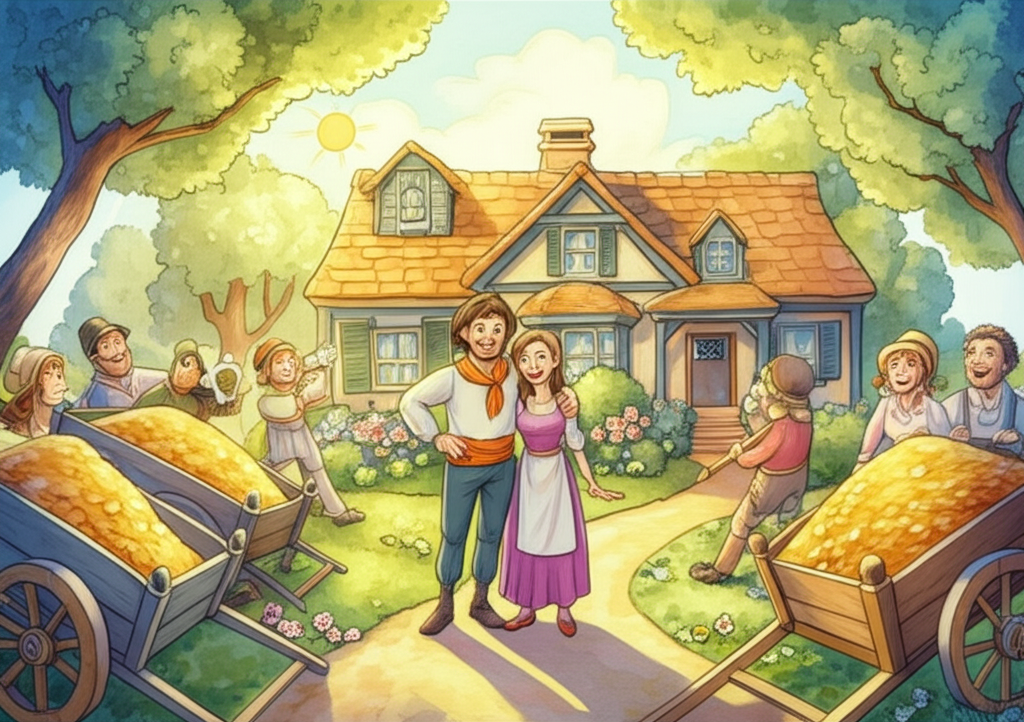Once upon a time, in a land far away, lived a grain seller’s son. His mom and dad loved him so much! They let him play all day and have fun, while they worked hard to take care of him. They didn’t teach him how to do anything, like a job or a chore. They didn’t think about what would happen when they weren’t around anymore, and he’d have to take care of himself. When he was old enough, they found him a wife, and they got married. Everyone was happy for a few years, until his mom and dad sadly passed away.
The son and his wife used the money his parents had left them. But his wife got sadder and sadder each day because the money was disappearing. She thought, “What will we do when it’s all gone? My husband doesn’t know how to do anything!” One day, when she looked really sad, her husband asked, “What’s wrong? Why are you so gloomy?” “We don’t have much money left,” she said. “What will we do when we run out? You can’t do any work!” “Don’t worry!” her husband said. “I can do some work!”
So, one day, when they were almost out of money, he grabbed an axe and told his wife, “I’m going to work today! Give me my lunch, and I’ll eat it outside.” She packed him some food, wondering what kind of work he could do. But she didn’t ask.
He went to a forest and stayed there all day, eating his lunch. All day long, he walked from tree to tree, asking, “Can I chop you down?” But none of the trees answered him. So, he didn’t chop any down and went home in the evening. His wife didn’t ask where he’d been or what he’d done, and he didn’t say anything either.
The next day, he asked her for lunch again, “Because,” he said, “I’m going to work all day!” She still didn’t want to ask questions, but she gave him the food. He took his axe and went to a different forest. In this forest, he asked every tree, “Can I chop you down?” But no tree answered. So, he ate his lunch and went home.
The next day, he went to a third forest on the third side of his house. He asked each tree, “Can I chop you down?” But none of them answered him. He went home feeling very sad.
On the fourth day, he went to a forest on the fourth side. All day long, he went from tree to tree, asking, “Can I chop you down?” Still, no one answered. Finally, as the sun began to set, he stood under a mango tree. “Can I chop you down?” he asked. “Yes, chop me down,” the tree answered. God loved the grain seller’s son and wanted him to become a great man, so He told the mango tree to let itself be cut down.
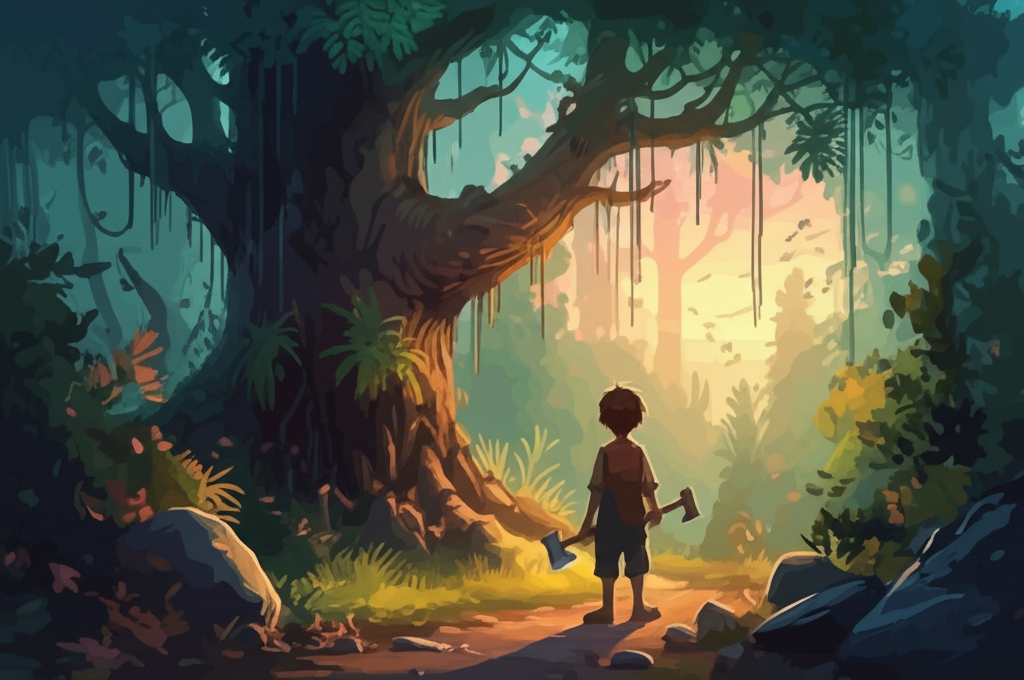
The grain seller’s son was so happy! He knew he could make a bed if he just had some wood. So, he chopped down the mango tree, lifted it onto his head, and carried it home. His wife saw him coming and thought, “He’s bringing home a tree! What’s he going to do with a tree?”
The next morning, he took the tree into a room in their house. He told his wife to bring him food and water to last him for a week and to light a fire in the room. Then he said, “Don’t come in here for a whole week. Don’t even come near me until I call you!” Then, he went into the room and shut the door. All week long, his wife wondered what he was doing in there all alone. “I can’t see inside,” she said, “and I don’t dare open the door. What could he be doing?”
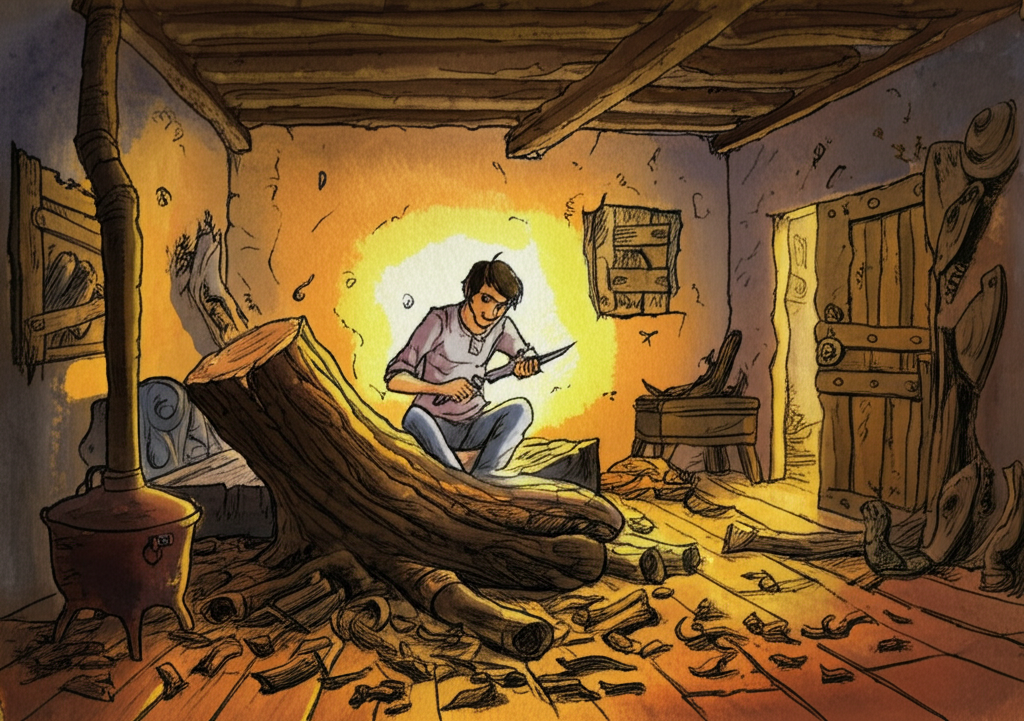
By the end of the week, the grain seller’s son had carved the most beautiful bed out of the mango tree. It was more beautiful than any bed anyone had ever seen! Then, he called his wife. When she came, he told her to open the door. When she opened it, he said, “Look what a beautiful bed I made!” “You made that bed?” she asked. “Oh, it’s so beautiful! I’ve never seen such a lovely bed!”
He rested that day, and the next day he took the bed to the king’s palace and sat down with it in front of the gate. The king’s servants all came to look at the bed. “What a bed!” they said. “Have you ever seen such a bed? It’s amazing! Is it yours?” they asked the grain seller’s son. “Is it for sale? Who made it? Did you make it?” But he said, “I won’t answer any of your questions! I’ll only talk to the king!” So, the servants went to the king and told him, “There’s a man at the gate with the most beautiful bed! But he won’t talk to us. He says he’ll only talk to you!” “Okay,” said the king, “bring him to me.”
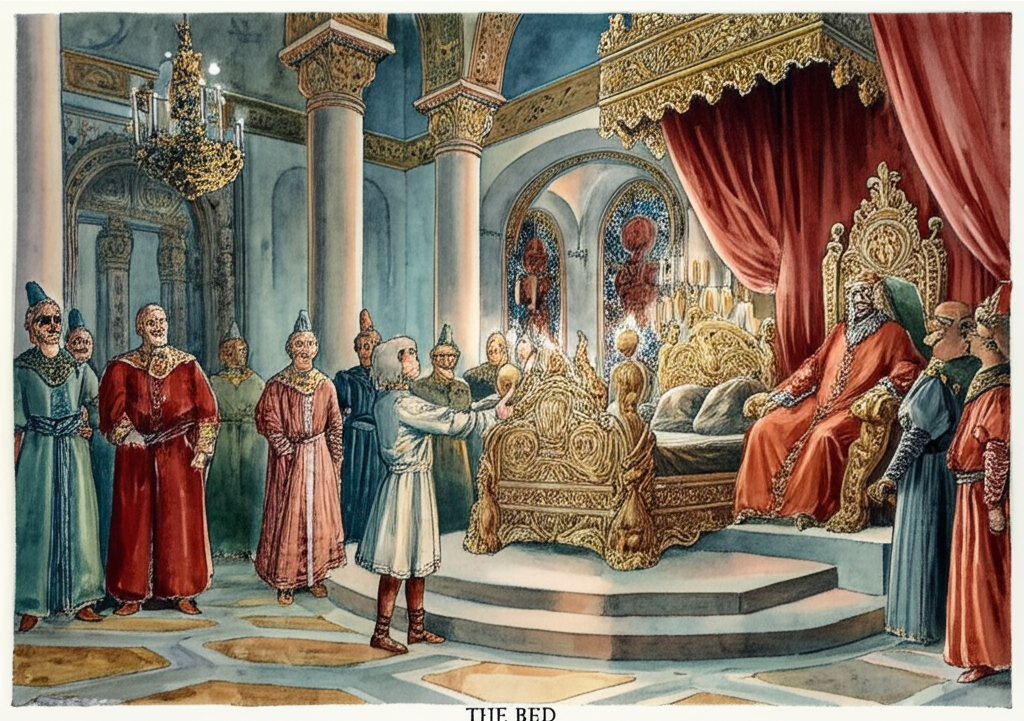
When the grain seller’s son came before the king with his bed, the king asked, “Is your bed for sale?” “Yes,” he said. “It’s a beautiful bed!” said the king. “Who made it?” “I did,” he said. “I made it myself!” “How much do you want for it?” asked the king. “One thousand rupees,” answered the grain seller’s son. “That’s a lot for a bed!” said the king. “I won’t take less,” said the grain seller’s son. “Fine,” said the king, “I’ll give you a thousand rupees!” So, he took the bed. The grain seller’s son said, “The first night you sleep on it, don’t fall asleep! Stay awake, and you’ll see and hear something!” Then, he took the money home to his wife, who was scared when she saw it. “Is this your money?” she asked. “Where did you get so much money?” “The king gave it to me for my bed,” he said. “I’m not a thief! I didn’t steal it!” Then, she was happy.
That night, the king lay down on his bed. At ten o’clock, he heard one of the bed’s legs say to the other legs, “Listen, you three! I’m going out to see the king’s land. Stay put while I’m gone, and make sure the king doesn’t fall!” “Okay!” the three legs answered. “Go have fun, and we’ll hold the king steady!”
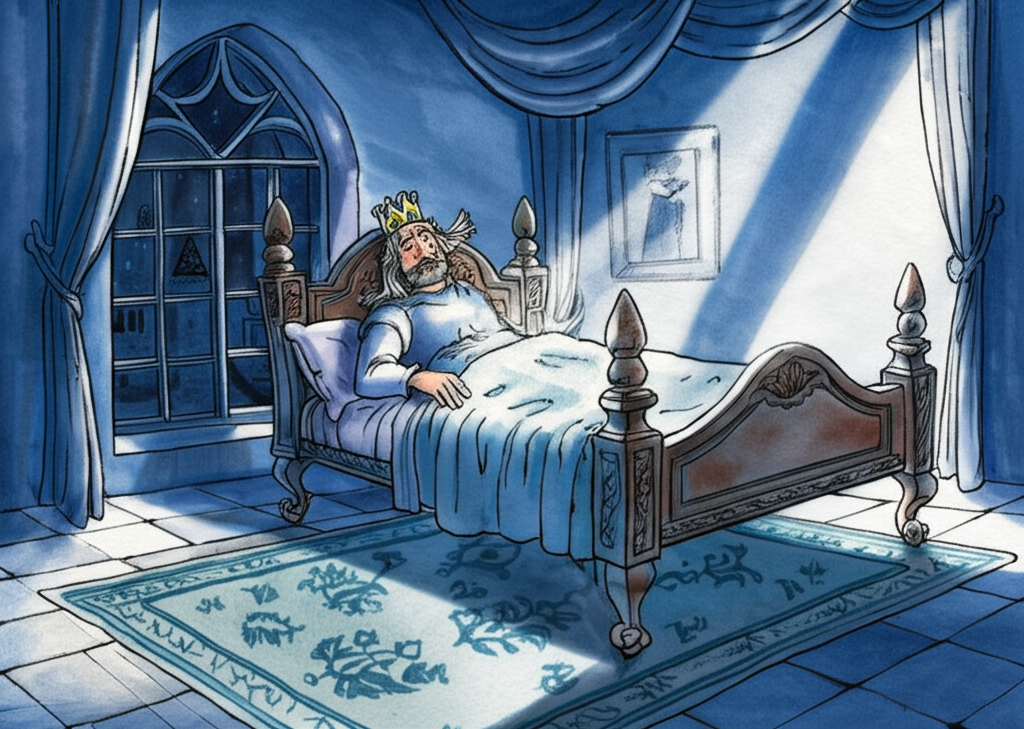
Then, the king saw the leg leave the bed and go out of his room. The leg went to a big field and saw two snakes arguing. One snake said, “I’m going to bite the king!” The other said, “No, I’m going to bite him!” The first snake said, “No, you won’t! I’m going to climb onto his bed and bite him!” “You can’t do that!” said the second. “You can’t climb onto his bed. But I’ll get into his shoe, and when he puts it on tomorrow morning, I’ll bite his foot!”
The bed leg came back and told the other legs what it had seen and heard. “If the king shakes his shoe before he puts it on tomorrow morning,” it said, “he’ll see a snake fall out!” The king heard everything.
“Now,” said the second bed leg, “I’m going out to see the king’s land. Stay put while I’m gone!” “Go!” the others answered. “We’ll make sure the king doesn’t fall!” The second bed leg went out and went to another field where there was a very old palace that belonged to the king. The wind told it that the palace was so old and broken that it would fall down and hurt the king if he ever went inside. The king hadn’t had it fixed in a long time. So, the leg came back and told the other three legs all about the palace and what the wind had said. “If I were the king,” said the second bed leg, “I would have that palace torn down! It’s about to fall! If the king goes inside, it will fall on him and hurt him!” The king lay still and listened to everything. He had forgotten all about his old palace and hadn’t been there in a long time.
Then, the third bed leg said, “Now I’m going out to see all the fun I can. Hold steady, you three, while I’m gone!” He went to a field where a wise man lived. Nearby was a small house where a soldier’s wife lived. Her husband had gone to another country a year ago, leaving her in the house. She liked the wise man a lot, and she would talk to him every night. That day, her husband came home. She got to the wise man later than usual, and he was annoyed with her. “You’re late tonight!” he said. “It’s not my fault!” she answered. “My husband came home today after being gone for a year, and he kept me.” “Who do you love more?” asked the wise man. “Your husband or me?” “I love you more!” said the woman. “Then,” said the wise man, “go home and cut off your husband’s head and bring it here for me to see!” The soldier’s wife went straight home, cut off her husband’s head, and brought it to the wise man. “You’re so mean to do that just because I told you to!” he said. “Go away! You’re a bad person, and I don’t want to see you!” She took the head home, put it back on the body, and started to cry. All the people in the small house came to see what was happening. “Thieves were here!” she said. “They killed my husband and cut off his head!” Then, she cried again. The third bed leg went back to the palace and told the others everything it had seen and heard. The king lay still and listened.
The fourth bed leg went out to see what it could. It came to a field where seven thieves were. They had just been to the king’s palace and had stolen his daughter while she was sleeping! She was still sleeping in the field. They had also stolen all of the king’s money from his treasure room! The fourth bed leg ran back to the palace and said to the other three legs, “If the king is smart, he’ll get up right now and go to that field! Some thieves are there with his daughter and all of his money that they just stole from the palace! If he hurries, he can get them back!”
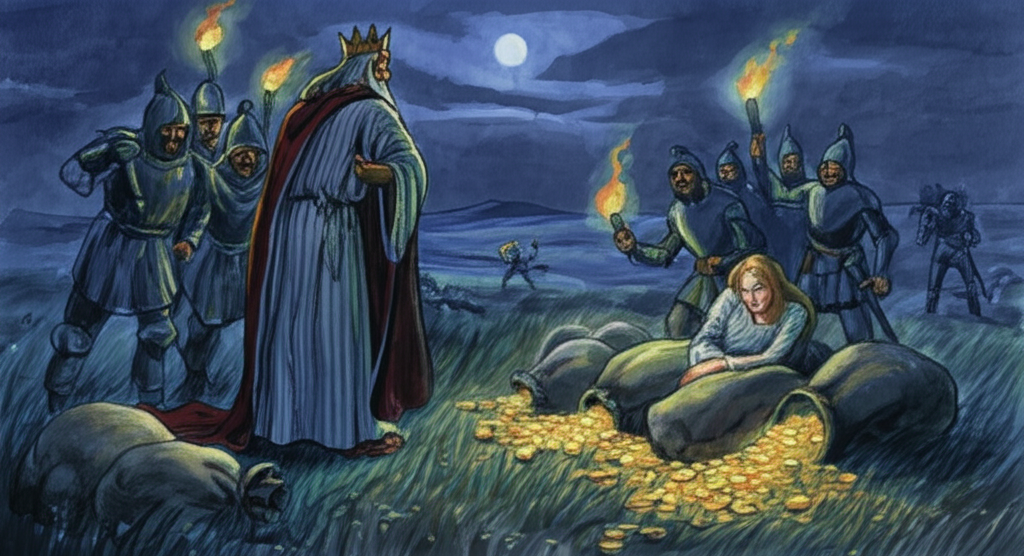
The king got up right away, called his servants and some soldiers, and set off to the field. He shook his shoe before he put it on, and the snake fell out! (The other snake had gone into the forest and didn’t come back.) So, he knew that the first bed leg had told the truth.
When he reached the field, he found his daughter and his money and brought them back to his palace. The princess was asleep the whole time and didn’t know what had happened. The king knew the fourth leg had told the truth. He couldn’t catch the thieves because they all ran away when they saw him coming with his soldiers.
The king sent men to the old palace to tear it down. They found out that it was about to fall and would have hurt anyone who went inside. So, the second bed leg had told the truth.
When the king was in his courtroom, he heard about how thieves had gone into the small house and killed a soldier and cut off his head. Then, he sent for the soldier’s wife and asked her who had killed her husband. “Thieves did!” she said. The king was angry because he knew the third bed leg had told the truth, just like the other three legs had. So, he decided to punish the wise man. He also ordered his servants to build a big pile of wood in the field. They took the woman and burned her on top of it. They had to stay there until she was no longer alive.
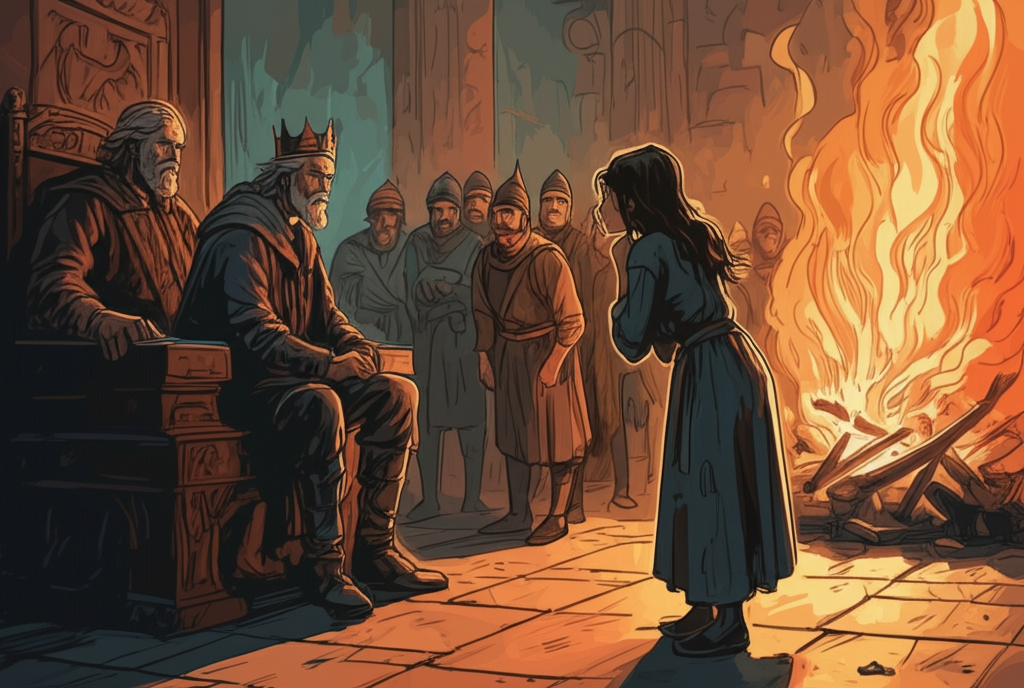
Next, he sent for the grain seller’s son and said, “If it hadn’t been for your bed, I would have been bitten by a snake this morning! I might have been hurt by my old palace falling on me because I didn’t know it was about to fall! My daughter would have been stolen! And that mean woman would still be alive! So, tomorrow, bring as many carts as you want, and I’ll give you as much money as you can carry away in half a day!”
Early the next morning, the grain seller’s son brought his carts and took away as much money as he could in half a day. His wife was so happy when she saw all the money! She said, “My husband only worked for one week, and he earned all of this money!”
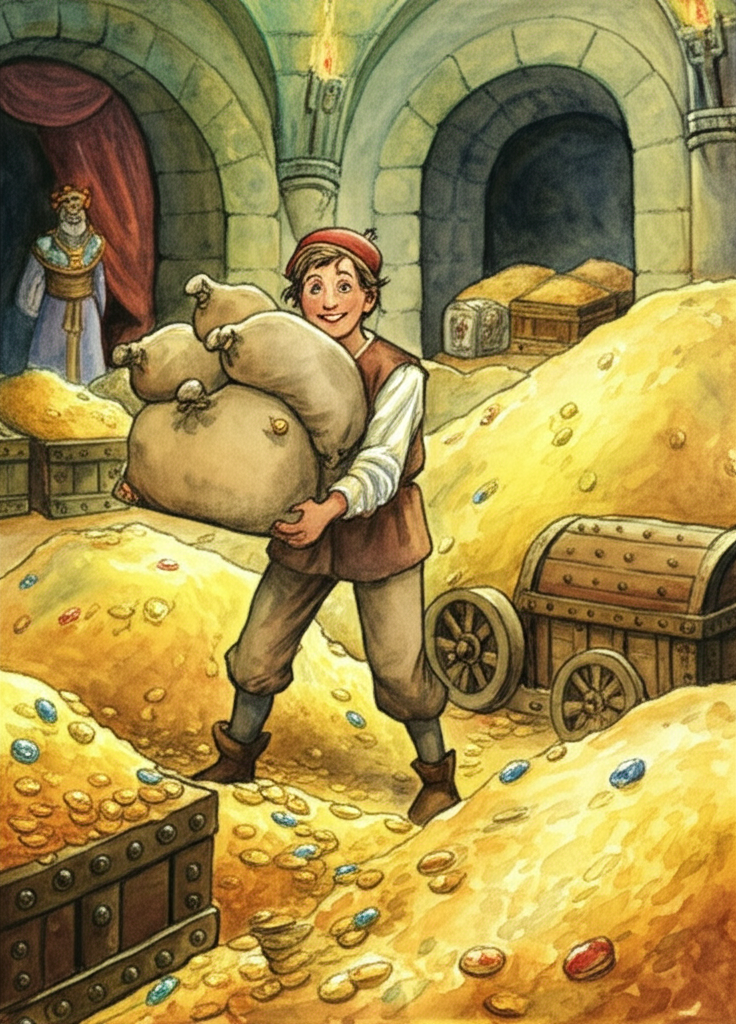
And they lived happily ever after!
